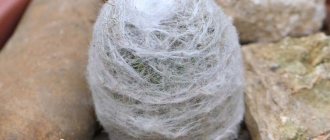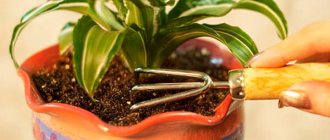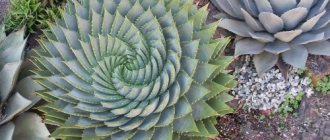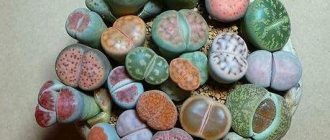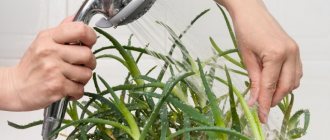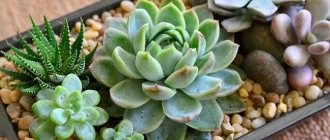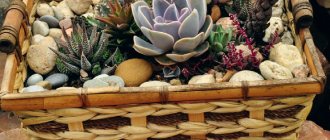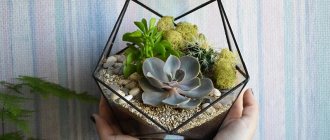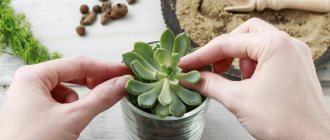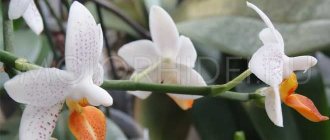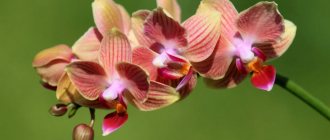The incredible variety of shapes, sizes, colors and textures is what makes succulents so attractive, along with their simplicity. These plants have adapted perfectly to conditions of constant water shortage. Pubescence is one of these devices (by the way, these hairs are called “trichomes”).
Pubescence performs 3 main functions: 1) protects plants from overheating; 2) reduces moisture loss from leaves due to drying wind; 3) protects against being eaten by animals - not everyone likes to eat fluffy foliage.
Haworth's ragwort (Senecio haworthii)
A dwarf perennial from the Asteraceae family, thanks to its original appearance, it has a second name: “Hare Ears”. The entire plant is densely covered with thick white hairs, making the surface appear woolly.
- bush height up to 30 cm, about half a meter in diameter;
- grows very slowly;
- the leaves are green, cigar-shaped and pointed, directed upward.
Under favorable conditions (extremely rare when grown at home), in the summer it produces a fluffy peduncle bearing bright yellow flowers.
@Drew Avery, Flickr
@pokysukkus, Instagram
Crassula mesembryanthemoides
A small ground cover plant, unpretentious to grow at home, with a thin fluffy stem. The sessile, oppositely arranged leaves are shaped like a pointed cigar. They are dark green and covered with sparse white downward hairs.
@beleafpottedtreasures, Instagram
@Ernest McGray, Jr., Flickr
Crassula Congesta
An attractive perennial that forms short, erect stems, up to 20 cm high, densely dotted with fleshy, triangular, pointed leaves.
- the color is light green or grayish, with a whitish velvety coating;
- In bright light, the foliage may take on a brownish tan.
It blooms with small white flowers collected in a large inflorescence - a cap. After flowering, the aboveground part dies off.
@plantmomeg, Instagram
@savedbysucculents, Instagram
Summer flowers
Summer is the most fertile time. The choice here can make your head spin. There are thousands of names, and they are all interesting in their own way. It’s very difficult to choose, but we tried to find decent options.
Summer is the time when the dacha is full of flowers
Dicentra - Broken Heart
The bright, unusually shaped flower of Dicentra became the reason for its no less unusual name and many legends relating to matters of the heart - Broken Heart. These are bright, tall flowers for the garden - up to 1 meter tall, attracting attention in mid-spring. There are 8 species, often found:
- Dicentra spectabilis. It blooms for a month, does not like nearby groundwater and summer drought. The plant is up to 1 meter tall, the leaves are green above, bluish below, large, pinnate. On a high arched peduncle there are bright pink large flowers - up to 3 cm in diameter. There is a white hybrid (Alba), a very interesting variety is Gold Heart (Gold Heart) - it has golden leaves.
The very unusual color and shape gave this plant its name - Broken Heart - Dicentra eximia. A low-growing species - up to 30 cm in height - with a very long flowering period - 2 months, starting from the second half of May. The leaves are green, in the form of a dense rosette, the flowers are bright pink, there is a white form. Overwinters in the ground without any problems.
- Beautiful Dicentra (Dicentra formosa). Another low winter-hardy species - up to 30 cm. It blooms all summer, starting from the end of May, so it can rather be called a summer flower. The foliage is a basal rosette, green above, bluish below. Tall stalks of bright, pink-purple flowers rise above the foliage. There are forms with white and pink coloring (Alba), bright pink flowers and bluish-gray leaves (King of Hearts).
There are also climbing species of Broken Heart - they can be placed on an arch, gazebo, pergola - Dicentra cucullaria. The smallest type has peduncles 8-15 cm high, flowers are white or pink, about 2 cm. The leaves are green, rugged, poisonous, and are used in medicine.
- Dicentra scandens. Climbing flowers for the garden, unusual in shape and color - white-pink or yellow flowers. They bloom, however, in early summer. In central Russia it is grown as an annual plant. There is a wintering variety - Golden Tears, which blooms all summer and almost all autumn. The flowers are yellow, with a pink tint at the edges of the petals.
Flowers Broken Heart require virtually no care and overwinter well. They can grow in the sun or shade; the ideal option is partial shade, where they bloom longer. They prefer light, slightly acidic soils with a significant supply of nutrients. The plants are unpretentious, but do not like waterlogging. In hot weather, mulch the soil, which will help against overheating, watering moderately. It is better to remove faded inflorescences - this will extend the flowering period.
Gypsophila
The genus Gypsophila consists of 100 plant species. So here you can find very different species - both tall and short. Plants come from different parts of the world, so the growing conditions are different. Here are a few that grow well in our area:
- Gypsophila paniculata. Tall (1-1.2 m) and medium-sized (60 cm) perennial plant with gnarled branches forming an openwork ball. The foliage is small, gray-green, flowers are small with a diameter of 0.5 cm, single and double, white, pink. Blooms in July, blooms from 45 days (terry, Flamingo, Pink Star, Bristol Fire, Rosie Weil) to 90 (Rosenschleier). Feels good in loose soils and does not need replanting. Does not like nearby groundwater, winters in open ground, but it is better to cover it.
Gypsophila is also called rocking, gypsophila, tumbleweed - Graceful gypsophila (Gypsophila elegans). Annual plants in the form of a spherical bush with small, very elegant flowers. The entire bush is translucent. Height - 30-40 cm, there are low-growing species - up to 0 cm in height. Flowers are white, carmine, pink. Collected in openwork panicles. There are a lot of flowers, but they disappear quickly - a week or a week and a half. Popular varieties: Rose, Double Star, Carmine.
- Creeping gypsophila (Gypsophila muralis). A herbaceous plant with creeping stems forming dense bushes. The foliage is lanceolate, small, the flowers are small, white or pink. The first flowering is in July, the second one is in the fall. Popular forms - White, Pink, Phratensis, Monstrosa, Letchworth Rose. After flowering, the shoots are cut off, after which the basal shoots grow. The species is unpretentious, prefers well-lit sunny places. Soils - preferably well-drained. It overwinters well, sometimes freezes out, but is restored by self-seeding. Ideal for planting in rock gardens; a bush hanging from a stone looks very, very decorative.
Creeping rock - looks great on the rocks
Reproduction is vegetative or by seeds. Prefers dry, well-lit places, grows well on calcareous soils. For normal growth, you can add 20-40 grams of lime per square meter of area.
List of summer garden flowers
When designing a flower bed, rock garden, or lawn, plants are selected so that several plants are constantly blooming. There are no fewer beautiful and capricious flowers for the garden than there are in spring. In this section we will briefly list and characterize them, and provide photos of the most common or attractive species.
- Astrantia or Zvezdovka. Perennial plant of the Apiaceae family. Well adapted to life under trees, so can be planted in deep shade. Tolerates any soil, but feels best on nutritious and sufficiently moist soils. It blooms all summer, without replanting it lasts up to 12 years. The leaves are large, deeply cut. Flowers - white, red, purple, pink. They are an umbrella consisting of many small flowers surrounded by wrapper leaves. Flowers and wrapper can be the same color, but often differ in shade. The most popular species are Astrantia major and Astrantia maxima.
Astrantia - beautiful flowers blooming all summer for the garden - Armeria. A beautiful flowering perennial plant. Blooms all summer. Narrow dark green leaves with a blue tint form a dense cushion from which tall peduncles protrude. Their height is from 30 cm to 130 cm. Capitate spherical inflorescences are collected from the smallest flowers. Color - from snow-white to red and bright lilac. They are not demanding about watering, they love plenty of sun, they grow on sand, between stones. There are about 50 species, but the most common are Alpine Armeria (Armeria Alpina), Prickly Armeria (Armeria pungens), Soddy Armeria (Armeria caespitosa), Seaside Armeria (Armeria maritima), Beautiful Armeria (Armeria pseudarmeria).
Armeria is an excellent decoration for any flower bed, rock garden, rock garden - Poskonnik (Eupatorium) A moisture-loving tall perennial plant (70-160 cm). Prefers loose fertile soils. Grows best in sunny places, but tolerates shade and partial shade. It blooms all summer, the flowers are collected in a complex paniculate or racemose shield. Color ranges from white to purple. The most common are spotted sapling (Eupatorium maculatum) and purple sapling (Eupatorium purpureum).
Pokonnik is a tall perennial plant that blooms all summer. - Aquilegia, Watershed, Orlik. These are all the names of one unpretentious flower, capable of growing on any soil, and at the same time having very beautiful flowers. Prefers shade, but survives in well-lit areas, although the flowering period is shortened. Color: white, red, yellow, blue, lilac. There are single-colored and two-colored ones. There are ordinary, double, and hybrid flowers.
Aquilegia (columbine) - another annual with very beautiful flowers
There are also some flowers that there is no need to describe, since they are familiar to everyone. You just need to remember their names. These are pansies, cornflower, gladiolus, iris, bell, lilies, daylily, delphinium, echinacea, chernobrivtsy, calendula, escholzia, lavaterra, matiola.
Echeveria pulvinata
Forms an almost stemless large rosette of pointed leaves. The height of the plant is no more than 12 cm, the diameter of the rosette is up to 13 cm. The leaf blade is slightly concave, light green in color with a red tip. It is covered with short white hair, making the plant velvety to the touch.
Echeveria pulvinata 'Ruby' @kakteenhaage, Instagram
Echeveria pulvinata 'Frosty' @kakteenhaage, Instagram
Autumn flowering period
In order for the flowerbed to please you until the coldest weather, you must remember to plant flowers with an autumn flowering period. There are not very many unpretentious flowers with such late flowering, but they are no less decorative.
Autumn flowers for the garden are not so numerous
Crocuses
We are accustomed to the fact that crocuses are primroses. But this flower also has autumn forms. Moreover, they are larger and no less decorative.
- Beautiful crocus (Crocus speciosus). The leaves are bright green with purple longitudinal veins and can reach a length of 20 cm. The flowers are lilac-violet with purple veins. The flowers are large, up to 7 cm in diameter. They bloom in autumn. There are varieties with dark blue, white, lilac, light purple, and blue flowers.
Autumn crocuses are one of the most interesting options for rockeries, ridges - Pretty crocus (Crocus pulchellus). The height of the flowers is 7-10 cm, the diameter is 6-8 cm. The color is light purple with dark veins. Each tuber produces 5-10 flowers. It blooms in September-October and tolerates light frosts.
- Banat crocus (Crocus banaticus). Another autumn crocus. It has an interesting flower shape - with a slightly elongated, pointed edge. The color is soft lilac, the leaves are long, silver-gray. The flowers are large - 12-14 cm high, leaves - up to 15 cm. There are numerous hybrids (Dutch) with spring and autumn flowering periods and different colors.
Helenium autumn
A perennial plant that begins to bloom in mid-summer and lasts until frost. Plant height is from 50 cm to 150 cm. Plantings form large bushes. Each stem can have up to 10 flowers. Flowers - red, yellow, orange. Large, up to 6 cm in diameter. Prefers sunny places, soils rich in humus. The following species are found in gardens and flower beds:
- Helenium autumnal Altgold. stems are straight, up to 80 cm high. Reed flowers - yellow inside, orange-red outside; tubular - yellow-brown. Blooms in August-September, early November.
- Helenium autumnale Augustsonne. Flowers up to 4.5 cm in diameter, yellow. It is distinguished by its abundance of foliage and height - up to 90 cm. It blooms in August and the first half of September.
Heleniums bloom in late summer - early autumn - Helenium autumnalis Herbstrot. Reed flowers are variegated, orange-brown, tubular yellow with brown. Flowering time - August/early September.
- Helenium autumnal Cockade (Kokarde). The flowers are red with a brown tint, with yellowish edges. Very tall species - up to 120 cm. Abundant flowering in August/September.
There are many more types. There are also forms that bloom in summer; by the way, there are more of them. But there are not so many autumn flowers. And helenium should not be neglected.
Aster perennial Aster (September)
Despite the similar name, they should not be confused with annual asters. This is a completely different plant. There are compact border species, and there are medium and tall ones. Prefers well-lit areas, nutritious soils. Flowers - white, blue, red, light blue, purple. The flowering period for autumn species is September-October.
- Virginia Aster (Aster novibelgii) or New Belgian. Tall variety - up to 2 meters tall. Blooms in October, if weather conditions permit, also in November. Flowers are 2.4-3 cm in diameter, purple, red, violet-red, pink. The middle is yellow.
Perennial asters - autumn flower for the garden - Heather aster (Aster ericoides). Compact tall species - up to 1 meter in height. The flowers are numerous, small - up to 1 cm. The petals are narrow, white or pinkish in tone, the middle is tubular, of different shades.
- Side flower aster (Aster lateriflorus). Tall bush - up to 120 cm in height, flowers are located along the shoots. Starts to bloom in September. The flowers at this time are white, the centers are light pink. Later the centers become bright pink.
Low-growing varieties - alpine, shrub - can be used as borders or planted in rockeries. Tall ones are planted in the background.
We recommend:
Echeveria Doris Taylor
Hybrid from crossing Echeveria pulvinata and Echeveria setosa.
The compact succulent is formed by a branched bush with a short woody stem and branches growing to the sides. The ends of the shoots are crowned with small (up to 5 cm) dense leaf rosettes of bright green color. The leaf is pointed, elongated, covered with short white hair, thicker on young growth.
@sukulen_house, Instagram
@eastcoastplanthoarder, Instagram
Drought-resistant indoor flowers
Drought-tolerant plants are great for gardens or sunny rooms. These flowers will allow the gardener to save on water.
Echeveria
Due to the special structure of the leaves, this plant can do without water for a long time; it will be enough to water it 1-2 times a month. Echeveria is sometimes called the stone rose
Lithops
You can often hear the name “living stones”. They love sunlight very much, and you can water them no more than once a month. Lithops can produce beautiful small flowers.
Spathiphyllum
Spathiphyllum, or “female happiness,” has a stunning appearance. Gardeners fell in love with it for its unusual flowers and unpretentiousness. The plant is believed to bring prosperity to the home. It really does not like excess moisture, especially in the cold season.
Zamioculcas
It has a rich green color and thrives in dry and hot places. It is often called the “money tree”. They say that it brings wealth to the house.
Delosperma echinatum
The succulent belongs to the Aizaceae family and is found naturally in Africa.
The bush is erect, at home not exceeding a height of 30 cm. Its leaves are quite large compared to the thin stem, cylindrical and pointed, light green. The surface of the leaf is covered with nodules - warts, some of them are crowned with white prickly hairs.
The flower is yellow and resembles a burdock bud.
@阿橋 HQ, Flickr
Kalanchoe beharensis
A tree-like succulent grown at home not only as an ornamental plant, but also as a medicinal plant. Forms a bush with a straight thick stem, 30-35 cm high.
Very large triangular or oval pointed leaves are olive green. They are velvety to the touch due to the short pile on their surface. The pile has a reddish tint on the front side of the sheet and silvery underneath.
@santacruzsucculents, Instagram
@Ezequiel Coelho, Flickr
Episcia
An ornamental deciduous plant of the Gesneriev family is popular among plant growers due to its unpretentiousness and bright beauty of the leaves. About the latter I would like to say that they are beautiful because of their velvety surface, interesting color, pearlescent tint and veins. By the way, small flowers only emphasize the beauty of the leaves and are also worthy of attention.
It is best to place a pot of Episcia on an eastern or western windowsill because it does not tolerate direct sunlight, but without light the beauty of its leaves will fade. Soft diffused light is what you need.
Somali Cyanotis (Cyanotis somaliensis)
Tropical perennial from the Commelinaceae family. Numerous creeping shoots of the plant are dotted with elongated, pointed leaves of bright green color. Along the edge and on the underside they are covered with long white hairs. It blooms with small bright blue flowers.
@FarOutFlora, Flickr
@slogrowers, Instagram
Ginura
Ginura is a unique indoor plant that has a fantastic appearance. Belongs to the Asteraceae (Asteraceae) family. The hairy, velvety leaves are bright purple and green. The plant should be protected from excess air and soil humidity. It is better to grow ginura on an eastern or western window. After a few years, it loses its decorative effect and needs to be replanted. The plant is poisonous, so you can only work with it with gloves!
Plectranthus tomentosa
Representative of the Lamiaceae family. The second name - “indoor mint” - was given to the flower for the pronounced minty aroma emanating from the leaves, if you touch them.
The bush is multi-stemmed, with long drooping shoots and numerous rounded green leaves with a wavy edge. Each leaf and stem is covered with sparse colorless hairs.
Important! The flower is very light-loving. When there is a lack of lighting, it stretches out greatly.
@succulentsdepot.com
Kalanchoe mysterious 'Copper Spoons' (Kalanchoe orgyalis)
Translated, the name means “Copper Spoon,” which refers to the unique shape and color of the succulent’s leaves. The leaf plate seems to be covered with a copper-golden velvet coating on the front part. This coloring is most pronounced on young growth; with age, the foliage becomes green.
It blooms with paniculate yellow inflorescences.
@entireleaves, Flickr
@jayteez, Flickr
